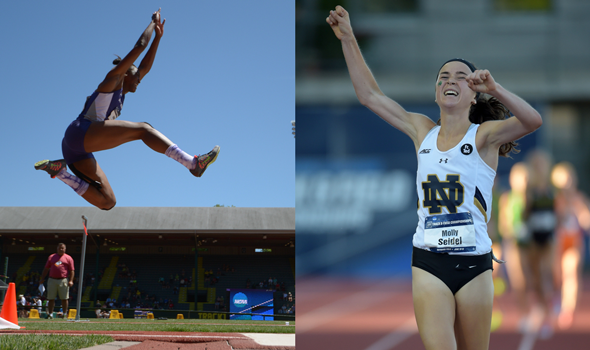
USTFCCCA News & Notes

NCAA Championships: Day Two Highlights
EUGENE, Oregon – If our team projections for the women’s team race at the NCAA Division I Outdoor Championships following Thursday’s competition are any indiction, we’re in for a great Saturday of women’s-only finals on ESPN2.
But before we get to Saturday and now that we’ve analyzed the team race, let’s dive into some of the many outstanding individual performances turned in on Thursday.
NATIONAL CHAMPIONSHIPS CENTRAL | USTFCCCA Notes
The semifinals on the track were largely free of the historic mayhem and drama of the men’s events on Wednesday, but the field event finals were a wild ride all the way from the heptathlon through the javelin, with historic hammer throw, long jump, pole vault and shot put competitions in between.
Plus a twist in the 10,000 meters final that no one saw coming.
That 10k was directed by M Night Shyamalan
— Kyle Merber (@TheRealMerb) June 12, 2015
Check out the highlights below.
Payne Outduels Morris in Historic Year of the Vault Finale
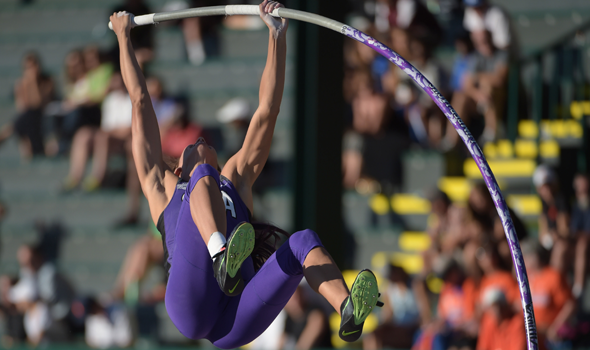
There could not have been a more fitting end to the collegiate chapter of the Year of the Vault than the head-to-head showdown between Demi Payne of Stephen F. Austin and Sandi Morris of Arkansas on Wednesday.
Payne redeemed herself for an indoor NCAA Championships no-height performance by taking the win at 15-5 (4.70m), while Morris came up just short at 15-3 (4.65m). The duel represents the highest combined height by two collegiate pole vaulters in the same competition. Never before had two collegiate women jumped 4.65m or higher in the same competition.
Payne was masterful in regaining the form that saw her set the indoor collegiate record, clearing six consecutive heights on first attempts all the way through 15-5 (4.70m) for what would ultimately be the winning clearance.
Outdoor collegiate record holder and indoor national champion Morris was exceptional as well, clearing her first four heights on first attempts before taking two to clear 15-1 (4.60m) and 15-3 (4.65m). She missed on her first go at 15-5 (4.70m) and, needing to force Payne’s hand, opted to pass to 15-7 (4.75m) to take her final two attempts.
She came close on both tries, but ultimately could not get the bar. Neither could Payne, but she took the crown by virtue of her clearance at 15-5 (4.70m). That jump gave the Payne/Morris duo each of the top 10 highest vaults in outdoor collegiate history.
The two left the former meet record of 14-7¼ (4.45m) in the dust, a mark equaled by third-place finisher Stephanie Richartz of Illinois.
One of these two will likely be among the three Bowerman Trophy finalists. Will it be indoor champ/outdoor collegiate record holder Sandi Morris? Or will it be outdoor champ/indoor collegiate record holder Demi Payne? Could both get the nod? Stay tuned.
Siedel Gets the First Track Upset of the Weekend at 10,000 Meters

Through 8400 meters, it looked like the women’s 10k was going to be a classic sit-and-kick, with a pack of twelve women within half a second of each other and clicking off comfortable 81s and 82s. Then defending champ Emma Bates threw in what will be remembered as one of the most infamous surges in meet history. The first lap of her last mile was covered in 66.41 seconds, putting her way ahead of the field. Only Notre Dame’s Molly Seidel and Oregon’s Waverly Neer were within eight seconds of Bates—at that pace, a massive gap of forty meters or so. Bates’s move blew up the field. Unfortunately for Bates, it blew her up too. Her last five laps were 80.84, 66.41, 84.22, 89.07, and 86.64. Seidel measured her effort better than anyone else in the field did, gradually covering Bates’s move and giving herself a huge cushion ahead of Scott. Scott and Seidel ran essentially the same last lap—69.89 for Seidel, 69.93 for Scott—but Seidel started that lap with a seven and a half second lead. The Notre Dame junior knew her pace better than anyone else in the field did, and it paid off with a stunning national title.
Burks and Prandini Battle to the End in Historic Long Jump Final

While the pole vault was flying historically high, the women’s long jump was soaring nearly as historically far horizontally. In a battle for the ages, collegiate leader Quanesha Burks of Alabama took down two-time NCAA long jump champ Jenna Prandini with a huge leap of 22-8w (6.91m, +2.6m/s) in the fifth round. The Duck superstar had been leading the competition with a career-best 22-3¾ (6.80m) leap in the third round before leaving to contest the 200.
Burks set the tone early with an opening leap of 21-11¾w (6.70, +3.6m/s) and a second-round 22-1½ (6.74m, +2.4m/s). To the delight of the home crowd, Prandini notched her big jump in the third jump to close out the first round. The mark is just one centimeter shy of the all-time top-10 performers list, and is equal to the No. 3 wind-legal jump in meet history (tied for sixth-best under all conditions, including wind-aided marks).
Prandini passed her next two jumps, in which time Burks catapulted back into the lead with her eventual winner and Kentucky’s Sha’Keela Saunders of Kentucky leapt past 22 feet with a 22-1¾ (6.75m) leap of her own that checked in a tie for the seventh-longest wind-legal jump in meet history.
Prandini couldn’t respond in the final round, fouling over the board to give Burks the win. The mark for Burks was the fourth-best all-conditions jump in meet history and 11th-farthest in collegiate history under all conditions.
Burks, Prandini and Saunders combined to tie the meet record for most jumpers over 22 feet, and Prandini’s teammate Jasmine Todd nearly pushed the group past the record, going 21-10 (6.65m) for fourth.
Granted the competition was windy – among each of the top eight athletes’ best marks, only Prandini’s and Saunders’ were wind-legal – but it was also incredibly deep. Prandini notched the best-ever mark by a runner-up at the NCAA Championships, Saunders tied for the best-ever third-place mark, and each of the next five finishers notched the best-ever marks for their respective finishing places.
Jones Dominates Best-Ever NCAA Championships Hepthathlon Field
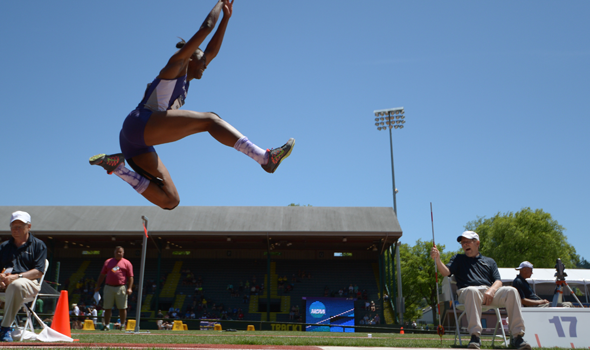
What if I told you that heptathlon champion Akela Jones of Kansas State is No. 4 all time on the collegiate list (No. 2 using the redesigned javelin since 1999) in just her second career heptathlon?
The Barbados native scored 6371 points for the fourth-highest score in collegiate history, finishing well clear of defending national champion Kendell Williams of Georgia (6223, No. 10 score in collegiate history), Quintunya Chapman of Georgia (6147) and former collegiate leader Erica Bougard of Missisippi State (6050).
After posting an all-time collegiate best 4023 points in Day One, she followed that up with an outdoor season’s best 21-5¼w (6.53m) and a career-best 125-1 (38.13m) in the javelin before running out of gas in the 800 at 2:29.43 for the third-slowest time in the field.
Not only did Jones dominate, but she dominated the most top-heavy field in NCAA Championships history. Never before had more than two women broken the 6000-point barrier at the NCAA Championships; four women did so this week, with Jess Herauf of Minnesota coming up just short at 5965 and 2013 NCAA Champion Lindsay Vollmer of Kansas on pace to surpass 6000 before fouling out in the long jump.
Southern Illinois Throwers Saunders & Price Sweep Shot Put and Hammer Titles
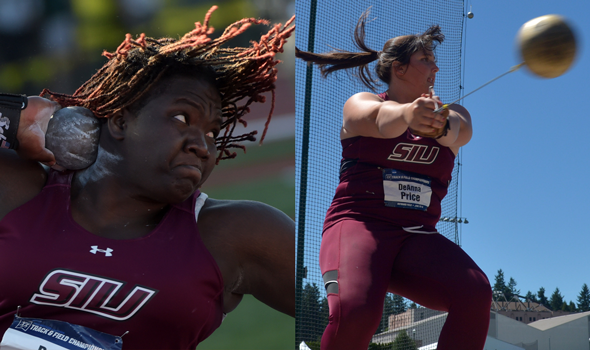
RESULTS: Shot Put | Hammer Throw
Raven Saunders was already on the list; you can now add DeAnna Price. That list, of course, is the women who have won NCAA titles in the throws under Southern Illinois assistant coach John Smith. Both Saunders and Price captured their championships on Thursday in dramatic fashion.
Saunders won an unusual shot put competition. Through five throws, Kelsey Card of Wisconsin was heading for an enormous upset, and Saunders was in third. Then, on her last throw, LSU’s Tori Bliss (the runner-up indoors and the descending order list leader) threw 17.83m (58-6) to bump Saunders down to fourth. Saunders had the second to last throw, and Card had the last, so Saunders had to risk it—if she only threw 18 meters, Card would be within 4cm with one throw to go. Saunders uncorked her loudest grunt and her farthest throw of the day at 18.35m (60-2½), extending her own American junior record and clinching her second NCAA championship of her freshman year.
Price’s championship was a little less stressful than Saunders’s, but no less dramatic. And the record it broke had to be particularly satisfying for Smith. After the second flight, Price and defending champ Julia Ratcliffe of Princeton were separated by just three centimeters, with Bowling Green’s Brooke Pleger another 27cm back. Ratcliffe and Pleger both fouled their fourth throws, and Price didn’t improve her mark. In the fifth round, Price gave herself some breathing room with a a throw of 68.33m (224-2), more than a meter ahead of Ratcliffe and Pleger but still behind their season bests. Those two failed to improve their marks, and Price stepped into the circle with the equivalent of a free throw—she knew she had the meet won. The Saluki junior took full advantage, as she threw the ball and chain 71.49m (234-6) for a new meet record. Price broke a record previously held by Jenny Dahlgren of Georgia, who stopped SIU’s Brittany Riley from winning hammer titles in 2006 and 2007. That makes Price the No. 3 performer in collegiate history and gives Southern Illinois three of the top five women’s hammer throwers ever.
Sediva Claims Javelin Title in the Final Round
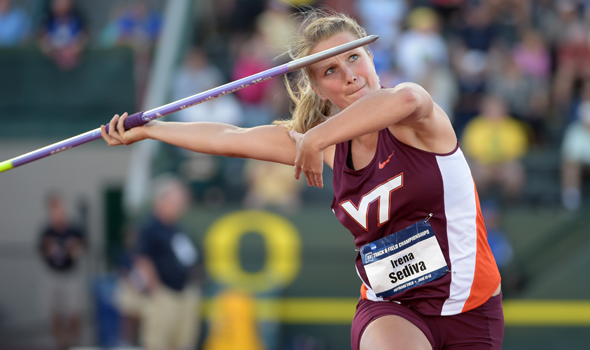
Late-round heroics wasn’t limited to just the shot put and long jump on Thursday, as collegiate leader Irena Sediva of Virginia Tech claimed the javelin title in the very last round on the second-to-last overall throw with a career-best 192-9 (58.76m) heave.
After three rounds, Hannah Carson of Texas Tech held the lead at 189-4 (57.72m) over Sediva at 188-3 (57.39m), which she would hold until the second-to-last throw of the competition, when Sediva launched her winner. Carson had one chance to respond and valiantly threw 189-1 (57.94m) in an attempt to regain the lead.
Sediva’s winning mark was the ninth-best throw in meet history.
